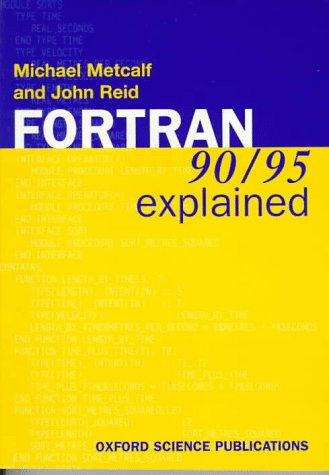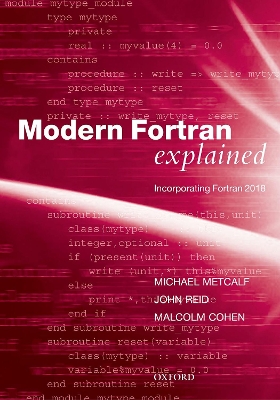Numerical Mathematics and Scientific Computation
2 total works
This updated examination of the FORTRAN programming language includes a more detailed explanation of many features, more examples, new appendices, and a new chapter on FORTRAN 95, which is a revision of the ISO FORTRAN 90 standard, based on the interpretations that have been requested following its implementation and use. In addition, new features to keep ISO FORTRAN aligned with High Performance FORTRAN have been added, along with a small number of minor improvements.
Fortran marches on, remaining one of the principal programming languages used in high-performance scientific, numerical, and engineering computing. A series of significant revisions to the standard versions of the language have progressively enhanced its capabilities, and the latest standard - Fortran 2018 - includes many additions and improvements.
This edition of Modern Fortran Explained expands on the last. Given the release of updated versions of Fortran compilers, the separate descriptions of Fortran 2003 and Fortran 2008 have been incorporated into the main text, which thereby becomes a unified description of the full Fortran 2008 version of the language. This clearer standard has allowed many deficiencies and irregularities in the earlier language versions to be resolved.
Four new chapters describe the additional features of Fortran 2018, with its enhancements to coarrays for parallel programming, interoperability with C, IEEE arithmetic, and various other improvements.
Written by leading experts in the field, two of whom have actively contributed to Fortran 2018, this is a complete and authoritative description of Fortran in its latest form. It is intended for new and existing users of the language, and for all those involved in scientific and numerical computing. It is suitable as a textbook for teaching and, with its index, as a handy reference for practitioners.
This edition of Modern Fortran Explained expands on the last. Given the release of updated versions of Fortran compilers, the separate descriptions of Fortran 2003 and Fortran 2008 have been incorporated into the main text, which thereby becomes a unified description of the full Fortran 2008 version of the language. This clearer standard has allowed many deficiencies and irregularities in the earlier language versions to be resolved.
Four new chapters describe the additional features of Fortran 2018, with its enhancements to coarrays for parallel programming, interoperability with C, IEEE arithmetic, and various other improvements.
Written by leading experts in the field, two of whom have actively contributed to Fortran 2018, this is a complete and authoritative description of Fortran in its latest form. It is intended for new and existing users of the language, and for all those involved in scientific and numerical computing. It is suitable as a textbook for teaching and, with its index, as a handy reference for practitioners.

